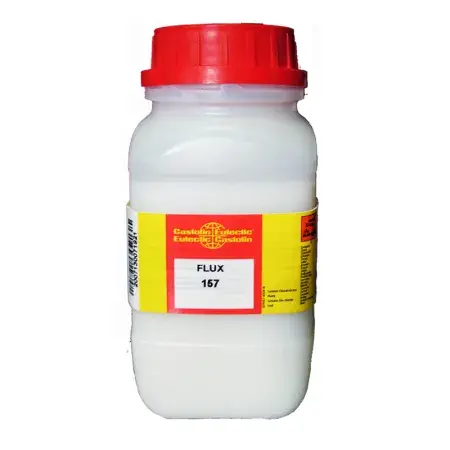
157 brazing flux
Liquid flux for soft soldering. Especially suited for stainless steels.
157 is a corrosive solder flux for many applications on stainless steel or for joining dissimilar metals. 157 flux is an efficient deoxidiser, and helps the filler alloy to spread evenly in the joint, rendering it tight and mechanically strong.
Promotes wetting out of the filler alloy. Easy removal of flux residues.
Procedure for use: Clean joint surfaces, eliminating all trace of grease and oxides. Round off corners slightly, and sharp edges. Apply 157 flux to whole joint area and on the filler rod.
If necessary, secure components in place for exact gap distance.
Torch procedure: Neutral or slightly carburising flame. Heat assembly slowly, making sure components have same temperature. On reaching the working temperature (slight bubbling of flux), melt the required amount of alloy with steady heat input. The alloy will flow towards the area of greatest heat. Avoid concentrating flame on alloy. Do not overheat. Other heat sources may be used, such as furnace, HF, soldering iron, etc.
Removal of flux residues: Allow the assembly to cool. Carefully remove flux residues with hot or cold water, brushing if necessary and not neglecting areas of difficult access, to avoid any risk of subsequent corrosion. Dry the assembly. Dangerous. Observe the precautions for use.
Promotes wetting out of the filler alloy. Easy removal of flux residues.
Procedure for use: Clean joint surfaces, eliminating all trace of grease and oxides. Round off corners slightly, and sharp edges. Apply 157 flux to whole joint area and on the filler rod.
If necessary, secure components in place for exact gap distance.
Torch procedure: Neutral or slightly carburising flame. Heat assembly slowly, making sure components have same temperature. On reaching the working temperature (slight bubbling of flux), melt the required amount of alloy with steady heat input. The alloy will flow towards the area of greatest heat. Avoid concentrating flame on alloy. Do not overheat. Other heat sources may be used, such as furnace, HF, soldering iron, etc.
Removal of flux residues: Allow the assembly to cool. Carefully remove flux residues with hot or cold water, brushing if necessary and not neglecting areas of difficult access, to avoid any risk of subsequent corrosion. Dry the assembly. Dangerous. Observe the precautions for use.
Popis
157 is a corrosive solder flux for many applications on stainless steel or for joining dissimilar metals. 157 flux is an efficient deoxidiser, and helps the filler alloy to spread evenly in the joint, rendering it tight and mechanically strong.
Promotes wetting out of the filler alloy. Easy removal of flux residues.
Procedure for use: Clean joint surfaces, eliminating all trace of grease and oxides. Round off corners slightly, and sharp edges. Apply 157 flux to whole joint area and on the filler rod.
If necessary, secure components in place for exact gap distance.
Torch procedure: Neutral or slightly carburising flame. Heat assembly slowly, making sure components have same temperature. On reaching the working temperature (slight bubbling of flux), melt the required amount of alloy with steady heat input. The alloy will flow towards the area of greatest heat. Avoid concentrating flame on alloy. Do not overheat. Other heat sources may be used, such as furnace, HF, soldering iron, etc.
Removal of flux residues: Allow the assembly to cool. Carefully remove flux residues with hot or cold water, brushing if necessary and not neglecting areas of difficult access, to avoid any risk of subsequent corrosion. Dry the assembly. Dangerous. Observe the precautions for use.
Promotes wetting out of the filler alloy. Easy removal of flux residues.
Procedure for use: Clean joint surfaces, eliminating all trace of grease and oxides. Round off corners slightly, and sharp edges. Apply 157 flux to whole joint area and on the filler rod.
If necessary, secure components in place for exact gap distance.
Torch procedure: Neutral or slightly carburising flame. Heat assembly slowly, making sure components have same temperature. On reaching the working temperature (slight bubbling of flux), melt the required amount of alloy with steady heat input. The alloy will flow towards the area of greatest heat. Avoid concentrating flame on alloy. Do not overheat. Other heat sources may be used, such as furnace, HF, soldering iron, etc.
Removal of flux residues: Allow the assembly to cool. Carefully remove flux residues with hot or cold water, brushing if necessary and not neglecting areas of difficult access, to avoid any risk of subsequent corrosion. Dry the assembly. Dangerous. Observe the precautions for use.
Aplikace
Industries in which 157 flux is used include: food processing, chemical, air conditioning and refrigeration, microtechnology, general engineering, electronics, household appliances, plumbing and other building installations.
Technická Data
Activity range
150-450°C
Norm
DIN 8511 F-SW12
Castolin Eutectic




